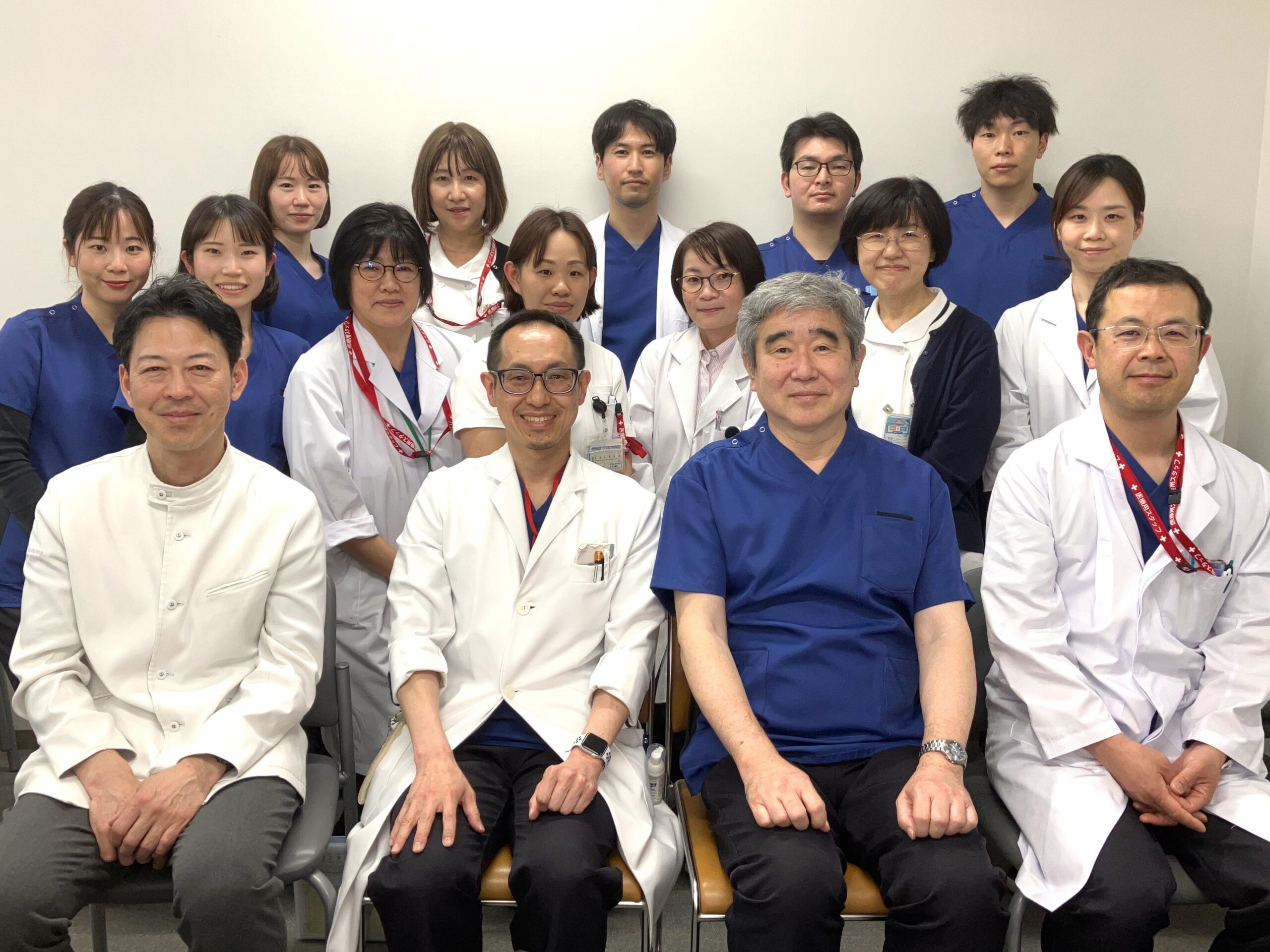緩和ケア内科は、院内の有志が立ち上げたペインコントロールチームから発展した緩和ケアチームでの活動実績を基盤として、平成24年7月から標榜診療科「緩和ケア内科」として診療にあたっています。当科が設立されたこの平成24年は、厚生労働省はがん対策推進基本計画(第2期)で「がんと診断されたときからの緩和ケアの推進」を重点的に取り組むべき課題として掲げた年であり、当院では、①がん治療と併行して、②入院・外来の区別なく「緩和ケア」を提供できるように体制を整備してきました。
WHO(世界保健機関)は、緩和ケアを「緩和ケアとは,生命を脅かす病に関連する問題に直面している患者とその家族の QOLを,痛みやその他の身体的・心理社会的・スピリチュアルな問題を早期に見出し的確に評価を行い対応することで,苦痛を予防し和らげることを通して向上させるアプローチである.」と定義しています。緩和ケアは「苦痛によって実践できなかったことが、できるようになる」ことを目的の一つとして、治療のどの段階でも受けることのできる医療です。
がん治療と言えば、手術・放射線治療・がん薬物療法を「がん治療の3本柱」とすることが多いですが、当院では緩和ケアを含めた4本の柱で、がん治療を受けている患者さん・ご家族の生活および生命の質の向上に努めていく所存です。
〈特長 ~外来から始まるチーム医療~〉
緩和ケア外来では、緩和ケアチームの専従医師が専従看護師、専任薬剤師と協働して外来診療にあたっています。できる限り外来にて症状緩和を行い、安心して自宅で過ごせるように配慮しています。外来診療の段階で多職種での関わりを持つことで、たとえば医療用麻薬の開始に際しても、少しでも不安を軽減できるように配慮しつつ、痛みを和らげながら安心して治療に臨んでいただけるように対応しています。
診療実績
緩和ケアチーム 年度別実績表
| 2020年 | 2021年 | 2022年 | 2023年 | 2024年 | ||||
|---|---|---|---|---|---|---|---|---|
| 外来患者 | 延患者数 | 2574 | 2589 | 2276 | 2270 | 2169 | ||
| 新規患者数 | 156 | 164 | 120 | 156 | 115 | |||
| 入院患者(全体) | 延患者数 | 353 | 374 | 425 | 503 | 472 | ||
| がん患者 | 全体 | 患者数 | 319 | 309 | 356 | 375 | 350 | |
| がん病名 | 大腸・直腸癌 | 患者数 | 19 | 26 | 35 | 25 | 31 | |
| 胃癌 | 患者数 | 27 | 25 | 23 | 28 | 30 | ||
| 膵癌 | 患者数 | 38 | 34 | 32 | 25 | 36 | ||
| 婦人科癌 (卵巣癌・子宮癌) |
患者数 | 22 | 23 | 40 | 28 | 29 | ||
| 肺癌 | 患者数 | 59 | 68 | 66 | 91 | 83 | ||
| 肝細胞癌 | 患者数 | 14 | 11 | 10 | 21 | 14 | ||
| 乳癌 | 患者数 | 19 | 20 | 17 | 24 | 19 | ||
| 介入項目 (身体症状) |
全体 | 患者数 | 348 | 373 | 420 | 497 | 468 | |
| 症状(重複あり) | 痛み | 患者数 | 281 | 288 | 316 | 46 | 333 | |
| 全身倦怠感 | 患者数 | 16 | 17 | 27 | 36 | 23 | ||
| 食欲不振 | 患者数 | 18 | 15 | 22 | 15 | 14 | ||
| 嘔気・嘔吐 | 患者数 | 15 | 24 | 32 | 30 | 29 | ||
| 腹部膨満 | 患者数 | 9 | 14 | 22 | 19 | 12 | ||
| 呼吸困難 | 患者数 | 45 | 56 | 71 | 90 | 94 | ||
| 腹水・胸水 | 患者数 | 5 | 11 | 12 | 8 | 7 | ||
| 咳・痰 | 患者数 | 3 | 2 | 10 | 9 | 16 | ||
| 便秘 | 患者数 | 2 | 2 | 5 | 3 | 3 | ||
| リンパ浮腫 | 患者数 | 0 | 0 | 0 | 1 | 1 | ||
| その他 | 患者数 | 9 | 12 | 2 | 7 | 7 | ||
| 介入項目 (精神症状) |
全体 | 患者数 | 134 | 142 | 146 | 215 | 183 | |
| 症状(重複あり) | 不安感 | 患者数 | 86 | 99 | 89 | 110 | 88 | |
| 抑うつ | 患者数 | 23 | 17 | 21 | 29 | 18 | ||
| せん妄 | 患者数 | 16 | 16 | 21 | 37 | 35 | ||
| 不眠 | 患者数 | 22 | 18 | 30 | 46 | 52 | ||
| 眠気 | 患者数 | 0 | 0 | 0 | 0 | 0 | ||
| その他 | 患者数 | 0 | 0 | 0 | 0 | 0 | ||
| 身体状況 | 日常生活動作(PS) | PS 0:問題なし | 患者数 | 43 | 33 | 32 | 44 | 49 |
| PS 1:軽い労働は可能 | 患者数 | 98 | 99 | 96 | 93 | 80 | ||
| PS 2:時に介助が必要 | 患者数 | 80 | 87 | 95 | 92 | 94 | ||
| PS 3:1日の半分以上 臥床 |
患者数 | 78 | 69 | 103 | 115 | 124 | ||
| PS 4:常に介助要 終日臥床 |
患者数 | 54 | 86 | 99 | 159 | 124 | ||
| 介入終了時の転帰 | 自宅退院 (外来通院) |
患者数 | 155 | 164 | 189 | 174 | 148 | |
| 自宅退院 (療養~看取り) |
患者数 | 21 | 34 | 23 | 27 | 41 | ||
| 一般病院転院 | 患者数 | 33 | 30 | 36 | 69 | 38 | ||
| 緩和ケア病院転院 | 患者数 | 57 | 43 | 46 | 48 | 62 | ||
| その他 | 患者数 | 18 | 23 | 30 | 48 | 44 | ||
| 死亡 | 患者数 | 69 | 80 | 101 | 137 | 138 | ||
| 退院支援患者 | 患者数 | 232 | 223 | 225 | 277 | 259 | ||
診療科別統計
主な疾患・治療法
治療対象
当院にて治療中の生命を脅かす重篤な疾患に伴う苦痛症状 全般を治療対象としています。
疾患単位
がん疾患 全般
(例)胃癌・大腸癌・肺癌・乳癌・膵癌・胆管癌・肝細胞癌・前立腺癌・腎細胞癌・頭頚部癌・卵巣癌・子宮体癌・子宮頚癌・白血病・悪性リンパ腫・多発性骨髄腫 など
非がん疾患
(例)非がん性疼痛(重症下肢虚血、腸管虚血、難治性慢性疼痛 など)・慢性心不全・間質性肺炎・新型コロナウイルス感染症の合併症/後遺症 など
治療法
苦痛となっている症状に対して適切と思われる苦痛緩和のための薬物療法やケアを提案・実施します。
医療用麻薬について
使用する薬剤の中には「医療用麻薬」も含まれます。医療用麻薬は、痛みや呼吸苦などの苦痛症状を緩和するための重要な薬剤です。
麻薬と聞くと不安になるかもしれませんが、医療用に開発のされたお薬ですので、適切に使用すれば麻薬中毒になることはありません。
心配されることとして「副作用」があると思います。たしかに副作用としては、眠気・吐き気・便秘をはじめ、口の乾き・発汗・幻覚などの症状が出ることもありますが、慎重に薬剤の種類や投与量を選ぶことで副作用の予防に努めることができますし、もしも副作用としての症状を生じたとしても、その症状を適切に評価し対処を行うことが可能です。
たとえば「がんの痛み」の場合、痛みが我慢できなくなってから医療用麻薬を使用するのではなく、痛みの初期から計画性をもって少量から開始することも可能です。
その使用に際しては担当医とよくご相談頂き、「良い薬」を「適切」に使用していきましょう。
緩和ケア応援医師の立場と業務内容
緩和ケア内科では、神戸市内で在宅緩和ケアに取り組んでいる緩和ケアの専門家と協働して、症状緩和を必要とする入院患者さんのチーム回診を行っています。
応援医師とは回診前後でのミーティングを行ってきめ細やかな情報共有を行い、「院内医師と同等の処方および指示権限」のもとで業務を実施いただいております。
在宅緩和ケアに取り組んでいる医師に応援を依頼しているため、退院後の療養についての具体的なアドバイスを得ることもできます。アドバイスに関しては応援医師の活動地域や患者さん・ご家族の環境によらず中立的に行っております。
2025年度応援医師予定表
(○のついている枠を応援医師がチーム回診を行います。ただし予告無しに変更となる可能性があります。)
| 月 | 火 | 水 | 木 | 金 | |
|---|---|---|---|---|---|
| 午前 | ○ | ○ | |||
| 午後 | ○ | ○ |
お知らせ
当院は地域がん診療連携拠点病院の認定を受けており、がん患者さん・ご家族への緩和ケア対応に力を入れておりますが、残念ながら緩和ケア病棟は有しておりません。そのため当院では、緊急時を除き基本的に緩和ケアのみを目的とした入院対応はできませんが、当院で実施可能な緩和医療(緩和的放射線治療、緩和的IVRなど)に関しては、当該疾患の治療担当科と協働して緩和ケア内科/緩和ケアチームも介入を行います。地域医療機関にて緩和ケアを中心とした療養を行っている患者さんでも、当院での対応が必要な病態であれば、治療担当科との併診で即日対応をいたしますので、お手数ですが治療担当科と緩和ケア内科への依頼書を作成の上でご相談頂けますと幸いです。ただし当院では神経ブロックに関しては実施できないため、その対象となる患者さんに関しては、必要に応じて専門機関への紹介をさせて頂いております※1)。
また、病状の進行などで緩和ケアを目的とした入院や施設入所が必要な方には、その時になって慌てることなく安心した療養に移行できるように、あらかじめ当院の地域医療連携センターと協力して緩和ケア対応の頂ける医療機関・介護施設への橋渡しを行っております。 我々は「在宅」の力がとても大きく尊いものだと常々感じており、患者さんにはできるだけ住み慣れた「おうち(自宅や施設)」で、ご家族や大切な方とかけがえのない時間を共有しながら療養をしていただきたいと考えておりますが、そのためには地域医療機関ならびに介護施設の皆様のお力添えが必要不可欠です。更には、最期まで「おうち」で過ごすためのサポート対応をいただける先生方と連携を深めていければと考えておりますので、ご協力のほど何卒よろしくお願いいたします
※1)当院から神経ブロックの相談実績のある高度医療機関:
神戸大学医学部附属病院 ペインクリニック科
神戸市立西神戸医療センター 緩和ケア内科





